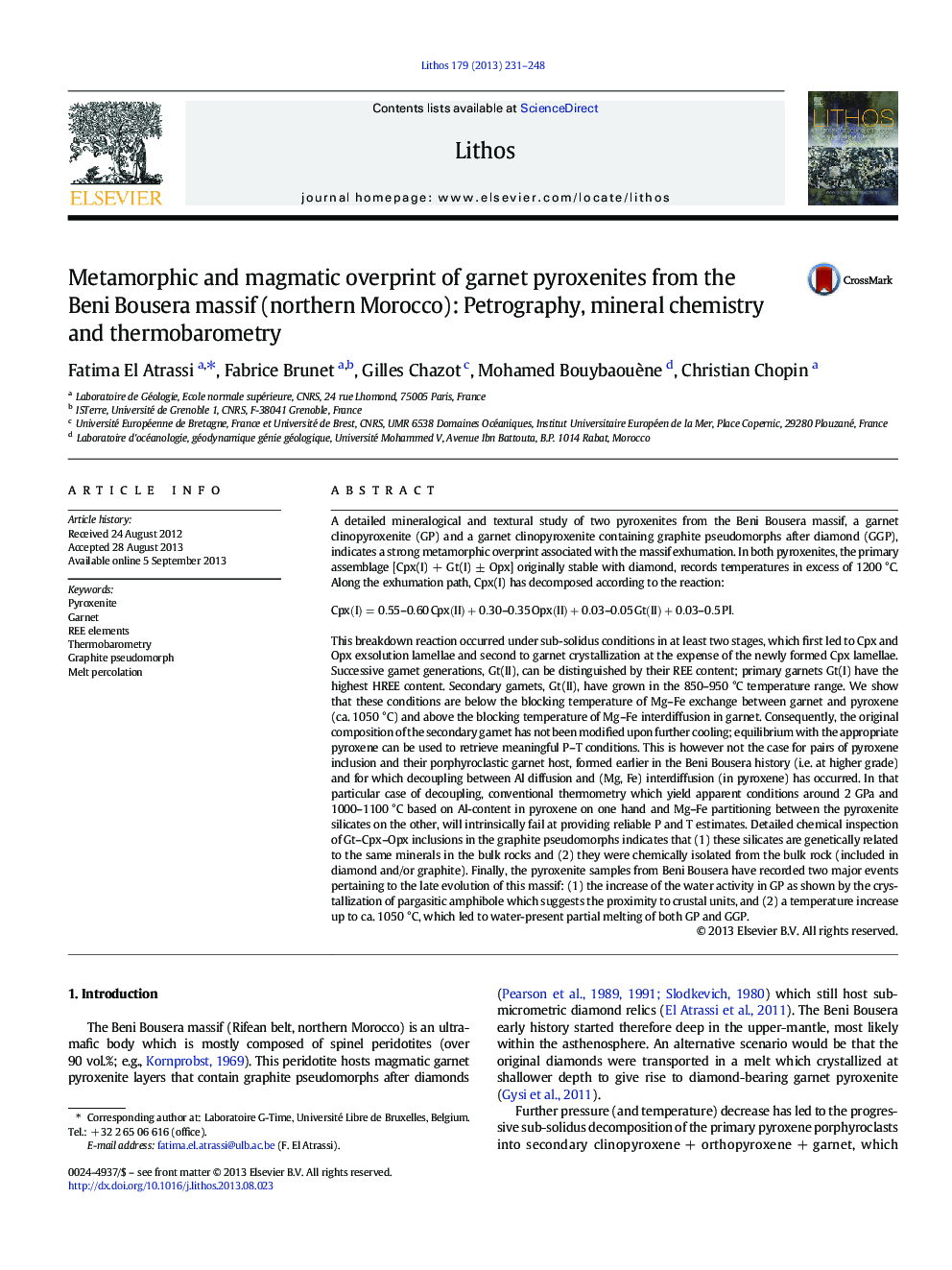| کد مقاله | کد نشریه | سال انتشار | مقاله انگلیسی | نسخه تمام متن |
|---|---|---|---|---|
| 4716214 | 1638686 | 2013 | 18 صفحه PDF | دانلود رایگان |
• Garnet pyroxenites of Beni Bousera indicate a strong metamorphic overprint.
• Primary assemblage Cpx(I) + Gt(I) ± Opx records temperatures in excess of 1200 °C.
• Secondary garnets have grown below the blocking temperature of the Mg–Fe exchange between garnet and pyroxene.
• Silicate inclusions in the graphite pseudomorphs are co-genetic with the primary assemblage.
A detailed mineralogical and textural study of two pyroxenites from the Beni Bousera massif, a garnet clinopyroxenite (GP) and a garnet clinopyroxenite containing graphite pseudomorphs after diamond (GGP), indicates a strong metamorphic overprint associated with the massif exhumation. In both pyroxenites, the primary assemblage [Cpx(I) + Gt(I) ± Opx] originally stable with diamond, records temperatures in excess of 1200 °C. Along the exhumation path, Cpx(I) has decomposed according to the reaction:CpxI=0.55–0.60CpxII+0.30–0.35OpxII+0.03–0.05GtII+0.03–0.5Pl.This breakdown reaction occurred under sub-solidus conditions in at least two stages, which first led to Cpx and Opx exsolution lamellae and second to garnet crystallization at the expense of the newly formed Cpx lamellae. Successive garnet generations, Gt(II), can be distinguished by their REE content; primary garnets Gt(I) have the highest HREE content. Secondary garnets, Gt(II), have grown in the 850–950 °C temperature range. We show that these conditions are below the blocking temperature of Mg–Fe exchange between garnet and pyroxene (ca. 1050 °C) and above the blocking temperature of Mg–Fe interdiffusion in garnet. Consequently, the original composition of the secondary garnet has not been modified upon further cooling; equilibrium with the appropriate pyroxene can be used to retrieve meaningful P–T conditions. This is however not the case for pairs of pyroxene inclusion and their porphyroclastic garnet host, formed earlier in the Beni Bousera history (i.e. at higher grade) and for which decoupling between Al diffusion and (Mg, Fe) interdiffusion (in pyroxene) has occurred. In that particular case of decoupling, conventional thermometry which yield apparent conditions around 2 GPa and 1000–1100 °C based on Al-content in pyroxene on one hand and Mg–Fe partitioning between the pyroxenite silicates on the other, will intrinsically fail at providing reliable P and T estimates. Detailed chemical inspection of Gt–Cpx–Opx inclusions in the graphite pseudomorphs indicates that (1) these silicates are genetically related to the same minerals in the bulk rocks and (2) they were chemically isolated from the bulk rock (included in diamond and/or graphite). Finally, the pyroxenite samples from Beni Bousera have recorded two major events pertaining to the late evolution of this massif: (1) the increase of the water activity in GP as shown by the crystallization of pargasitic amphibole which suggests the proximity to crustal units, and (2) a temperature increase up to ca. 1050 °C, which led to water-present partial melting of both GP and GGP.
Journal: Lithos - Volume 179, 1 October 2013, Pages 231–248
